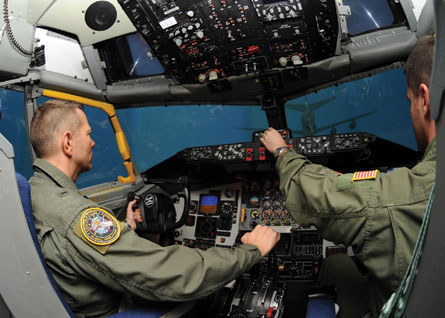Successful vertical expansion is tricky for any business, but CAE's decision a decade ago to migrate from the design and manufacture of simulator equipment into the provision of training itself has paid off for a company which describes itself as the "last pure play" in the sector.
Helped by the surge in pilot demand in the mid-2000s, Montreal-based CAE's training business has grown to 28 facilities, and today the provision of services accounts for two-thirds of CAE's revenues on the civil side (on the military side the ratio is reversed). Some 80,000 crewmembers are trained by CAE every year.
The one-time Canadian Aviation Electronics' activities are balanced in a way that would keep any financial director or shareholder worried about cyclical downturns happy. Half the company's $1.5 billion revenues come from the military and half from commercial. Its turnover is split roughly three ways between North America, Europe and the rest of the world. Although all its engineering and production is carried out in its large plant in Dorval, Montreal, half its 7,500-strong global workforce is in 20 other countries.
"There's no real magic to our growth story," says Jeff Roberts, group president of CAE's civil business. "We lead from a technology standpoint, from a global and a service standpoint. We have a global mindset and we work in developing markets. We are everywhere from Brazil to India. When everyone else was talking about doing something in emerging markets, we were doing it."
A lack of a rigid mindset when it comes to how to grow the services business has also helped. "We have gone down the route of greenfield investments, acquisitions and local partnerships," says Roberts. "We are not predisposed to any one way of doing it."
On the equipment side, CAE - which was founded by a former Royal Canadian Air Force officer in 1947 to provide training devices for the country's military - is "proud of doing more prototypes than anyone else", says Roberts.
"We continue to put 10% of all our revenues straight back into R&D. When a Bombardier or a Mitsubishi decides they are going to build a new aircraft, the low-risk option [for the simulator] is CAE. If we commit to being there at an agreed price point, we will."
 |
|---|
©CAECAE has won a USAF contract to provide KC-135 training |
Military market
CAE began in the military market and today its business in that sector spans everything from the manufacture of full-mission simulators, through providing outsourced training packages, to supplying modelling and simulation software through a subsidiary called Pregasis (see box opposite page).
Over the past five years, says Martin Gagne, Roberts' counterpart on the military side, the company has "made a concerted effort to position CAE on platforms that we say have long legs, that should be around for a long time".
These include the Eurofighter Typhoon, Lockheed Martin C-130J, Airbus A330 multi-role tanker transport, helicopters such as the NH Industries NH90, Boeing CH-47 and Sikorsky H-60 as well as the Aermacchi M-346 multirole trainer.
CAE's involvement often starts at the earliest stage of the programme. "Because of our experience on platforms such as these, which often involves developing the prototype training systems, we can offer customers proven solutions with lower risk," says Gagne.
As on the civil side, training is becoming a more important part of the business mix. Contracts include major partnerships on helicopter training with the UK and German ministries of defence. CAE also owns a large facility in Tampa, Florida, that last December was awarded a US Air Force contract to provide Boeing KC-135 training. As part of the deal, CAE will carry out courses at 13 bases, training more than 3,500 aircrew annually.
Plans include harnessing aerospace training expertise into new markets, including land and sea defence, as well as sectors such as mining and healthcare.
In terms of technology, CAE is looking at the concept of "dynamic synthetic environments", allowing, says Gagne, the military to plan for missions using what-if analysis and rehearse in real time "in a synthetic environment that changes dynamically, just like the real world".
The simulation sector began in earnest when the 1973 oil crisis forced operators to find cheaper but realistic ways of training pilots. Ongoing pressures on costs will compel airlines to seek better value for money when it comes to training, without compromising safety, says Roberts. That will drive innovation.
"The airline business model will continue to be challenged, so airlines will go on looking for ways to become more efficient, and that includes more effective training."
 |
|---|
©CAEMilitary and civil revenues hover equally |
Source: Flight International























